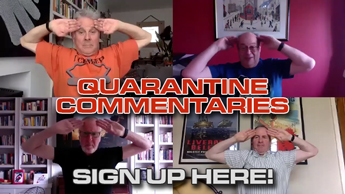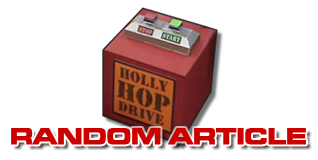Back to Blade Runner
Homage aplenty as we break down those Back to Earth references.
28 October, 2011
Much has been said about the Blade Runner homages in Red Dwarf: Back to Earth. Ridley Scott's classic dystopia flick was referenced in dialogue - but it was the imagery that made the difference.
So here, in chronological order, is a rundown of Back to Earth's biggest visual references. Be warned - it's too bad you won't avoid spoilers forever. But then again who does?
Origami Figures
Blade Runner: Limping Cityspeaker Detective Gaff - played by Battlestar Galactica's Edward James Olmos - has a curious habit of making origami figures. This pays off hugely in the Director's/Final cut of the movie, where an origami unicorn clues us into a huge realisation: Gaff knows Deckard's dreams, suggesting the blade runner himself is a replicant.
Back to Earth: Here Cat's origami figures also indicate a huge realisation - that the crew are suffering under a squid ink-induced hallucination. Bonus points for lining Cat up as a parallel to the crazily-dressed Gaff.
Click images to enlarge
Snake Scale
Blade Runner: Searching a replicant's bathroom, Deckard (famously doubled by stuntman Vic Armstrong rather than drag Harrison Ford in for additional shooting) finds a scale from an artificial snake. It leads him to his target.
Back to Earth: Lister's filthy bathtub from the TV series - he was in that when he heard that Kochanski had 'died' - includes a snake scale. As shown in Polymorph, showing on a TV in the shop during this scene, Lister was once attacked by a big rubber snake. The maker of the prop is named on the scale, leading the crew to...
Click images to enlarge
Zoom In
Blade Runner: A photo found among the replicants' belongings is forensically examined by Deckard. Through manipulation of the image he finds an image of one of the artificial humans he's chasing.
Back to Earth: A photo of prop maker Swallow at a fan convention is forensically examined by the Dwarfers. The result: the character's address.
Click images to enlarge
Nose World/Swallow
Blade Runner: Replicant Roy Batty confronts eye-maker Chew. "If only you could see what I've seen with your eyes." (A line parodied in one early draft of the Back to Earth script by Kryten: "Stew, if only you could have blown what I've blown with your nose.") They tear the coat from Chew's body, causing him to shiver in his sub-zero workplace.
Back to Earth: "Chew", "Swallow" - you see what they did there. Lister and the gang confront Swallow, who is wearing Cat's fur coat. Also rejected in the early stages was the creation of a 'dreadlock coat' for Lister to match Chew's tube-heated outfit in Blade Runner.
Click images to enlarge
Tyrell Building
Blade Runner: In the midst of futuristic Los Angeles, the pyramid-like Tyrell building stands tall and intimidating.
Back to Earth: In the midst of contemporary London, the pyramid-like Creator's building stands next to the Houses of Parliament, dwarfing even Big Ben, as Carbug approaches.
Click images to enlarge
Animated Billboard
Blade Runner: Surrounded by flying cars and other neon, this massive animated billboard was a hugely iconic image from the movie.
Back to Earth: The FX team, always wary of a visit from the Plagarism Police, changed the ethnicity of the billboard girl: one's Chinese, the other's Japanese.
Click images to enlarge
Rimmer Munchkins
Blade Runner: Genetic designer J F Sebastian builds large-scale toys for company - including these two bizarre military beings who greet guests upon arrival.
Back to Earth: As seen in Blue, the Rimmer munchkins entertained/irritated with their song. Here, instead of puppets, the munchkins were created by tracking Chris Barrie's head onto two children.
Click images to enlarge
The Creator and His Home
Blade Runner: Eldon Tyrell built replicants to be utterly human-like - but gave them a limited lifespan. His vast, candlelit chambers reflect a decadent life financed by the manufacture of sentient slaves. One could easily draw comparisons between the film's replicants and the unsettlingly-human 3000 series mechanoids mentioned in Out Of Time. (In the end, Batty kills him.)
Back to Earth: The Creator is much more Tyrell than he is Grant/Naylor. The crew discover him at home and debate their longevity with him. Various references to "Tyrell" were removed from the script to make sure nobody mistook this homage for a deliberate use of the exact same character. (In the end, Lister kills him.)
Click images to enlarge
Street Chase
Blade Runner: Deckard chases Zora through the L.A. street and eventually shoots her in the back, bringing an end to the life she'd hoped to extend. Her figure crashing through the glass and fake snow of shop windows is yet another iconic image from a movie dense with such things.
Back to Earth: The Creator - switching from the parody role as replicant-builder to that of the blade runner himself - chases the Dwarfers down the street wielding a gun loaded with bullets which have the characters' names on. He shoots all four in the back, even neutralising Rimmer's light-bee.
Click images to enlarge
Sad Farewell
Blade Runner: Taken from the original cinema cut - and not present in the later Director's/Final versions - this was Blade Runner's 'happy ending' as Deckard and replicant Rachael head out of the city into green hills to begin a new life. The mountain road footage was taken from rushes to Kubrick's The Shining.
Back to Earth: Also utilising stock footage - a grand Red Dwarf tradition - Lister and his imaginary Kochanski get sucked deeper into the hallucination. Like Blade Runner, we never see a clear shot of the exterior of their vehicle...which is just as well, as a full reveal of the silly-looking Carbug would have undercut the gravitas of this dramatic concluding scene.
Click images to enlarge
The Final Homage
Okay, this one's more a happy accident, but still - Blade Runner was famously re-released in a Director's Cut in 1991, based mostly on an earlier edit of the film. This was before a true director's cut - known as the Final Cut and fully Ridley Scott approved - arrived in 2007. Back to Earth's three-part broadcast story is, unusually for Red Dwarf, not considered the definitive version. Instead Doug Naylor's DVD/Blu-ray Director's Cut is 'the' version to see.
Unlike Blade Runner, Back to Earth's director's cut retains its happy ending...


Click images to enlarge




















































